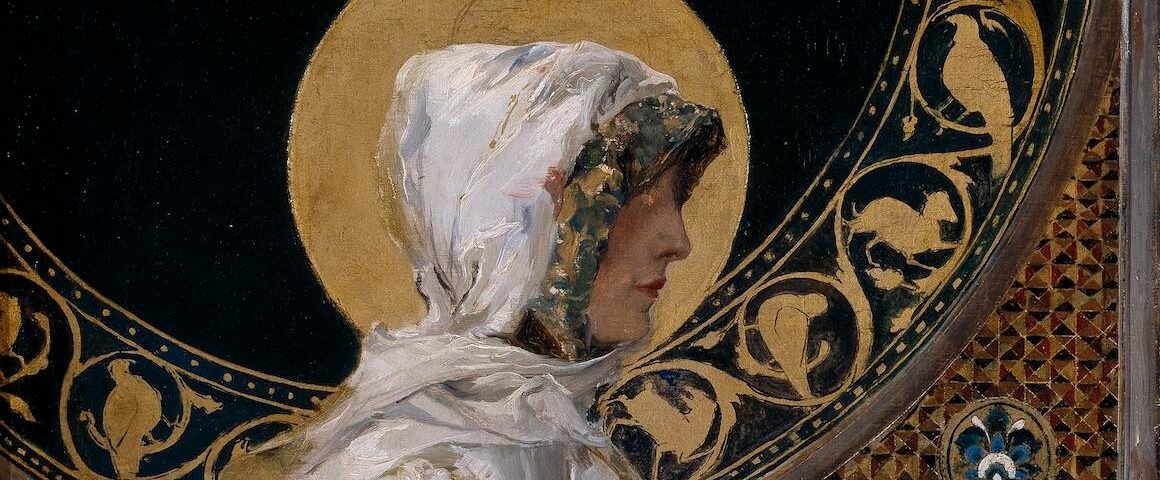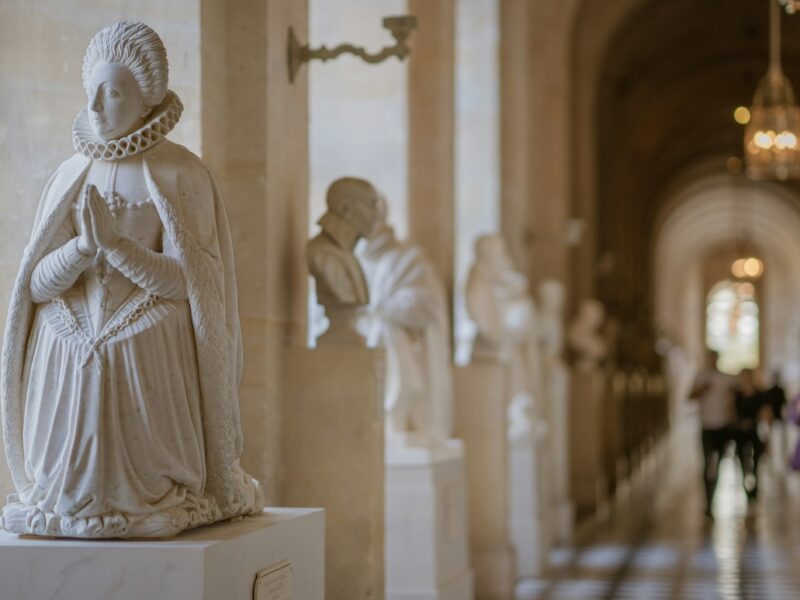O how sweetly
the voices resound there
when all the Holy Ones
sing the praises of God
saying: sanctus
Thus we also praise
the Lord on earth
whom the holy angels
praise in the highest
saying: sanctus
You alone make
clean from unclean
cleanse us, as long as we are in the world
because you alone are: sanctus
– Sanctus O quam dulciter (Holy O How Sweetly) [1]
***
There’s a line toward the end of Lewis’s Chronicles of Narnia series where Mr. Tumnus the Faun says to Lucy about the land of Narnia, “The further up and the further in you go, the bigger everything gets. The inside is larger than the outside. …[It’s] like an onion: except that as you continue to go in and in, each circle is larger than the last.”[2]
The Sanctus we pray, or rather, proclaim, at the beginning of Holy Communion proper, feels a bit like that. It’s just a few lines long, but suddenly, heaven itself bursts in on us. We are “joining our voices with Angels and Archangels and…all the company of heaven.” Though on earth, we are in heaven. Even if we gather with few on earth, the communion gathered in these words is bigger than we know.
We “sing this hymn to proclaim the glory of [God’s] Name.” Simple enough. But what does it mean?
Scriptural & Historical Background
Scripturally, the Sanctus is composed of two passages. The first is Isaiah’s earth-shattering vision of the Lord in Isaiah 6:1-7. Heaven is opened and Isaiah is undone. Notice that the cry of “holy, holy, holy” is not said to the Lord, but about him. Likewise, as we sing to each other, we join the seraphim, who at one and the same time continue to cry forth “holy” even as they cover their eyes before uncreated light.
The second half, called the Benedictus or Benedictus Qui Venit (blessed is he who comes), is from the Triumphal Entry (Matt. 21:9, Mark 11:1‒11, Luke 19:28‒40, John 12:12‒19). Matthew tells us that as Jesus entered Jerusalem, “The crowds that went before him and that followed him were shouting, ‘Hosanna to the Son of David! Blessed is he who comes in the name of the Lord! Hosanna in the highest!’” (Matt. 21:9) Hosanna most literally means, “save now!” Of course, that would entail far more than the crowds knew. We do know, and so with even greater joy we welcome the Lord Jesus into our midst with the acclamation of the Sanctus.
So how did it come to be part of the Church’s liturgy? Well, its use probably dates to the 3rd-century anaphora (eucharistic prayer) of Addai and Mari.[3] However, it was almost universal in the celebration of the Eucharist by the 4th century.
Even more important than the question of when is the why. Understanding and applying the “why” of the Sanctus will open up every celebration of Holy Communion we participate in.
Transcendence & Immanence
The Sanctus we pray together proclaims the transcendence and the immanence of God. Put differently, both the untouchable holiness of God and the Incarnation of Jesus Christ are on display in these lines, preparing us to receive the Eucharist. Think of it – in the Sanctus, heaven and earth come together in the person of Jesus. Then, in Communion we are invited to receive his body and blood! The bread of heaven on earth ‒ transcendence and immanence.
Here, no longer must we fear the wrath of God, but instead we are invited to take our place in creation, invited through the peace of Jesus. Author Leander Harding writes, “Now we are restored. Now we are as whole as it is possible to be this side of the grave. The terrible separation that exists between humanity and God has been overcome. We take our place in union with God’s angels and the saints of every generation, reveling in the goodness and loving kindness of God, God’s love of us overflowing into awe, wonder, and thanksgiving toward him.”[4]
In the Sanctus, we are reminded that we are welcomed back into the communion of heaven – redeemed humanity and the highest holy angels are at peace. But more than that, we are at peace with the Lord of Glory who is at the center of it all. We have gone up…and God has come down. Righteousness and peace have indeed kissed. (Psalm 85:10)
The Gospel in the Sanctus
And this brings us to the gospel. The Sanctus is a powerful, explicit proclamation of the good news. Anyone present and listening will be evangelized by what they hear. It proclaims that Christ’s body given and blood shed are the sole means by which we can again sing God’s song with the rest of the created order. In fact, the hosanna we sing anticipates the shouts to crucify Jesus. At the word “blessed,” many Anglicans will make the sign of the cross. Leander Harding notes, “Here [making the sign of the cross] seems a not unfitting recognition that we sing our praises in the shadow of the cross.”[5] Jesus most fully came to us, and stood in our place, through his willing submission to the cross. Here we are reminded of both our culpability and the overwhelming grace of God on our behalf.
Interestingly, in his Deutsche Messe (German Mass), Luther recommended moving the Sanctus to follow the words of institution because he saw them as a proclamation of reconciliation. “The bread and wine were the tokens or seals of that promise, and they touch the lips of the communicant as a declaration of forgiveness. After the communion, the Christian is sent out as a servant of God. Thus, the Sanctus was a fitting conclusion to the proclamation of the testament of forgiveness, that is, the words of institution.”[6]
Anticipating & Participating in the Wedding Banquet
Lastly, in the Sanctus, we both anticipate and participate in the Wedding Feast of the Lamb (Revelation 19:6‒10). In the Eucharist, we proclaim that the Feast is here, and it is coming. As St. Paul says, “[We] proclaim the Lord’s death until he comes.” (1 Corinthians 11:26) Here, we long for the consummation of God’s Kingdom in the New Heavens and the New Earth and we see it happening in real time. We see it in the lives of our brothers and sisters, gathered under Jesus’ lordship around the Table over all the world. And think of it: what we see physically is just a tiny slice of the Bride of Christ.
Memorably, in The Voyage of the Dawn Treader, C.S. Lewis pictures Holy Communion as Aslan’s Table, “Set here by his bidding…for those who have come so far. … For though you can sail further, this is the beginning of the end [of Narnia].”[7] There is a greater alleluia to come, but it is already on our tongues and in our hearts as we celebrate together in the Sanctus around the Table of the Lord. Thanks be to God for his inexpressible gift!
Notes
- From the Analecta Hymnica, a collection of medieval hymns. As quoted in Spinks, Bryan, The Sanctus in the Eucharistic Prayer (New York: Cambridge University Press, 1991), 146. ↑
- Lewis, C.S., The Last Battle (New York: Harper Collins, 1956), 224‒5. ↑
- Deiss, Lucien, Springtime of the Liturgy (Collegeville: The Liturgical Press, 1967), 158. ↑
- Harding, Leander, In the Breaking of the Bread (Eugene: Wipf & Sock, 2011), 55. ↑
- Harding, In the Breaking of the Bread, 57. ↑
- Spinks, The Sanctus in the Eucharistic Prayer, 151. ↑
- Lewis, C.S., The Voyage of the Dawn Treader (New York: Harper Collins, 1952), 218. ↑





'The Sanctus: Bigger on the Inside' has no comments
Be the first to comment this post!